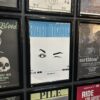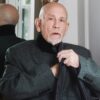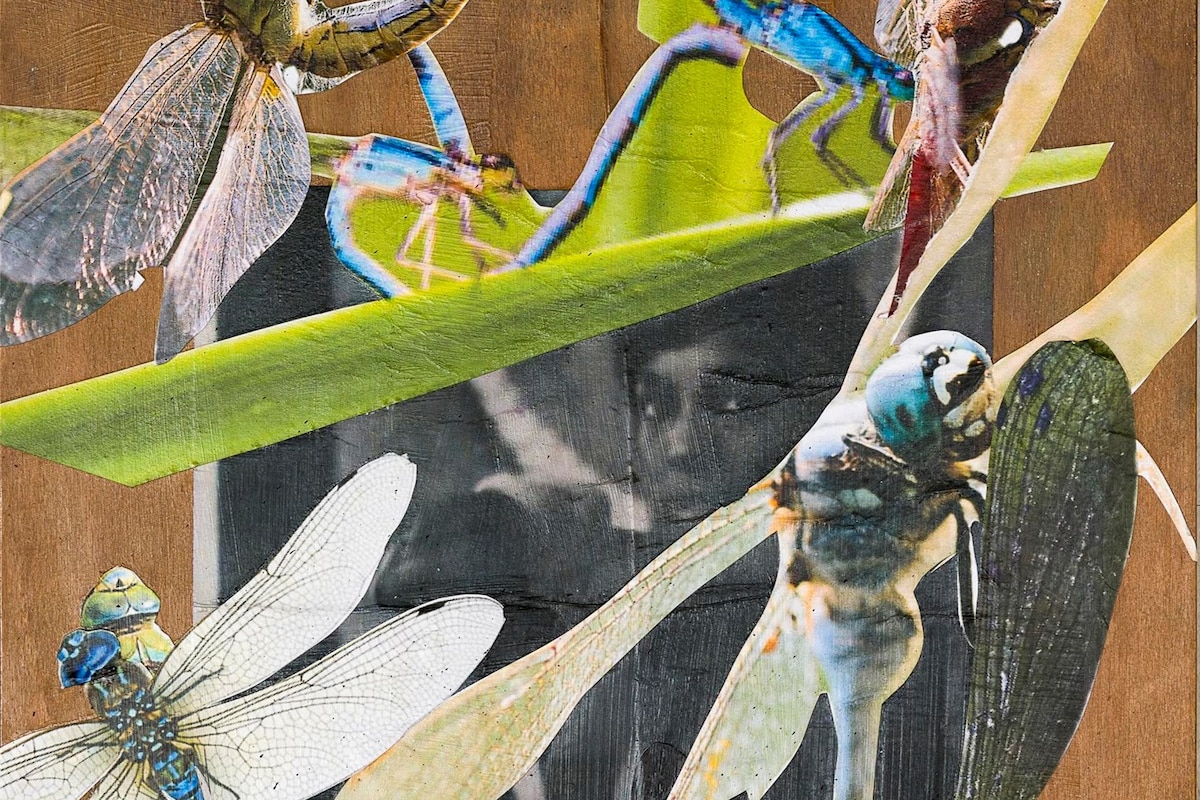
Rewrite
目次
- 1 From Miu Miu’s Helen Marten commission to the visually rich work of Kandis Williams, here are eight highlights from Art Basel Paris 2025
- 2 Siyi Li at Cibrián
- 3 Tanoa Sasraku at Vardaxoglou
- 4 Jala Wahid at Sophie Tappeiner
- 5 Janet Olivia Henry, Gordon Robichaux and Stars
- 6 Ethan Assouline at Gauli Zitter
- 7 Helen Marten at Palais d’Iéna
- 8 Sophie Kovel at Petrine
- 9 Kandis Williams at Heidi
- 10 From Miu Miu’s Helen Marten commission to the visually rich work of Kandis Williams, here are eight highlights from Art Basel Paris 2025
- 11 Siyi Li at Cibrián
- 12 Tanoa Sasraku at Vardaxoglou
- 13 Jala Wahid at Sophie Tappeiner
- 14 Janet Olivia Henry, Gordon Robichaux and Stars
- 15 Ethan Assouline at Gauli Zitter
- 16 Helen Marten at Palais d’Iéna
- 17 Sophie Kovel at Petrine
- 18 Kandis Williams at Heidi
From Miu Miu’s Helen Marten commission to the visually rich work of Kandis Williams, here are eight highlights from Art Basel Paris 2025
Hot on the heels of Frieze London comes Art Basel Paris, a highlight in the Swiss franchise’s growing arsenal of global trade fairs. With some 206 galleries in participation this year, the event sees the Grand Palais – a 20th-century glass-roofed landmark off the Champs-Élysées – come alive with patrons, dealers, curators and critics, each attempting to see as many works as possible. Last year, there were around 336 art fairs across the world. Art Basel Paris was and remains one of the most important.
Luckily, Art Basel Paris is smartly laid out, separated into three core sections: Galeries, Emergence and Premise. Respectively, they purvey impressive multi-artist displays, newer artists and tight, curatorially acute presentations. These are joined by innumerable satellite happenings. Conversations, a successful talks series, held in the adjacent Petit Palais, is exemplary. Last year, the billing included fashion designers August Barron (then All-In), K-Hole’s Dena Jago, artists Ana Viktoria Dzinic, Jamian Juliano-Villani, Diego Marcon, Jane Dickson and Futura 2000, plus poet James Massiah and curator Hans Ulrich Obrist. This year, a series dedicated to the 90s – curated by Edward Enninful and featuring Mark Leckey, Yinka Shonibare, Sonia Boyce and Juergen Teller – takes centre stage, alongside a talk with photographer Tyler Mitchell.
All this comes at a particularly fraught period for the art world. In tandem with a volatile economy and geopolitical unrest, the global art market, per Art Basel and UBS, has shown dwindling sales in the past two years. It has, however, displayed some positive signs in the sales of lower price point works, hopefully making way for both rising and overlooked artists.
From young artist Siyi Li, through to mid-career star, Kandis Williams, here are the highlights from Art Basel Paris.
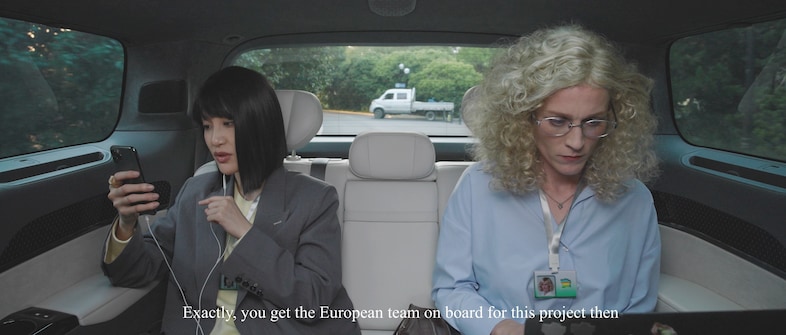
Siyi Li at Cibrián
It’s rare that a Gen-Z artist would pick up traction as fast as China-born Siyi Li. Living and working between Shanghai and Frankfurt, Li studied at the Slade (BA) and Städelschule (Meisterschüler). He approaches his work through a medley of media – painting, drawing, sculpture, film, photography, music – using them to unpack complex, messy emotions and to crystallise ephemeral moments. “I’m obsessed with temporality in my work – whether it’s the idea of longevity or a millisecond of the shutter,” he explains.
In this vein, he is showing a film, New Energy (2025), alongside the study drawings for it. Shot in Shanghai with a cast of artist friends, the work started life as a photo editorial, later morphing into a narrative-led video. Through a series of scenarios, the actors present the exacting resilience – witty in the face of chaos yet totally present – that a city like Shanghai breeds. The immediacy of fashion and the gradual cadence of cinema are, here, combined. “Using the Chinese term for electric vehicles as a metaphor, New Energy is, in a way, an open-ended answer to the role of creativity – whether through fashion, art or any form, it remains crucial to our vitality, especially in urgent [times],” notes Li.
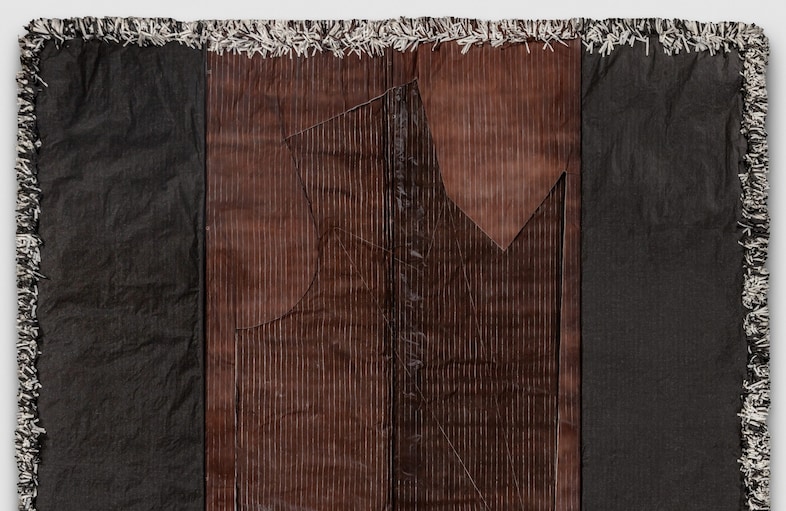
Tanoa Sasraku at Vardaxoglou
Already showing at ICA London for her institutional solo, Sasraku arrives in Paris with a large-scale, sculptural counterpart. At the former, 32 acrylic paperweights containing crude oil are on display – amongst other works – and at the latter, a monolithic, free-standing work called Mascot, fabricated from newspaper, thread, ink and mineral pigments (from Cornwall and Ghana) and wood. Both, explains the Glasgow-based artist, interrogate notions of masculine ambition – to accumulate wealth and power, say – and loss. They also, pertinently, represent elements of her own heritage.
A Goldsmiths and Royal Academy alum, Plymouth-born Sasraku has made her name on salvaged and heavily wrought works. Textiles and patternmaking are an integral part of the practice, informed by her late Ghanaian father Kofi Ansah’s history as a fashion designer. “The work that I am presenting at Art Basel Paris is the climactic expression of this material and formal language,” she says. “In a way, it is a resurrection of and monument to previous works.”
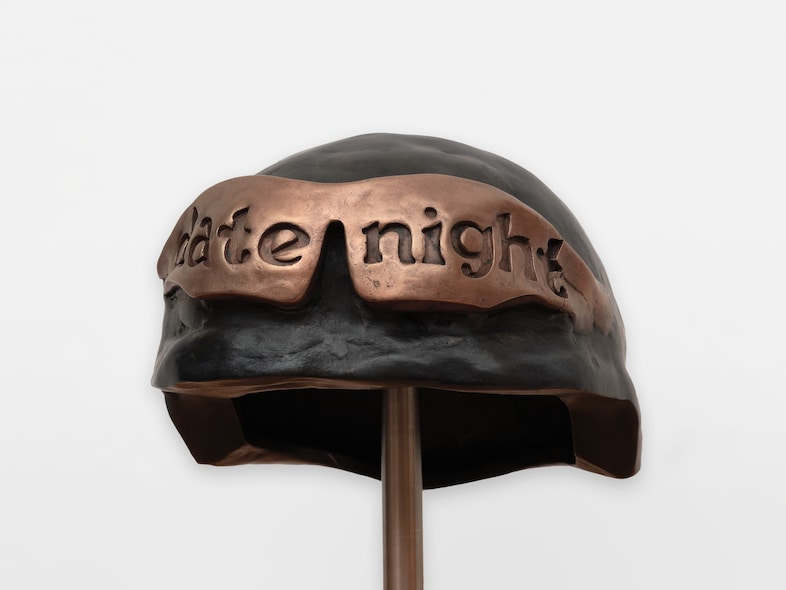
Jala Wahid at Sophie Tappeiner
Arresting, ostensibly toxic and rigorous, Jala Wahid’s work takes root in her study of state violence, empire and colonialism. Based in London, the artist has built a practice spanning film, sculpture, installation and even sound, however, as she puts it, subjects are always tackled through a “material” lens, “looking at the potential and charge of material in carrying and conveying histories.”
For Art Basel Paris, she presents a body of work entitled Stealth Technology, a reference to anti-detection tactics employed by militaries, as well as her parents’ less academic but equally ingenious methods of hiding while fleeing Kurdistan in the mid-80s. In one particular sculpture, Behind the Scenes (2025), the goggles of a military helmet are carved with the words, “date night”, an ode to the fact that even while living in an Iranian refugee camp, her parents found ways to love, despite mortal danger. “I see the sculptures as sites of collision where the visual languages of both are caught on the verge of pulverising one another, moments of violence found in combination with moments more intimate and resilient,” the artist explains.
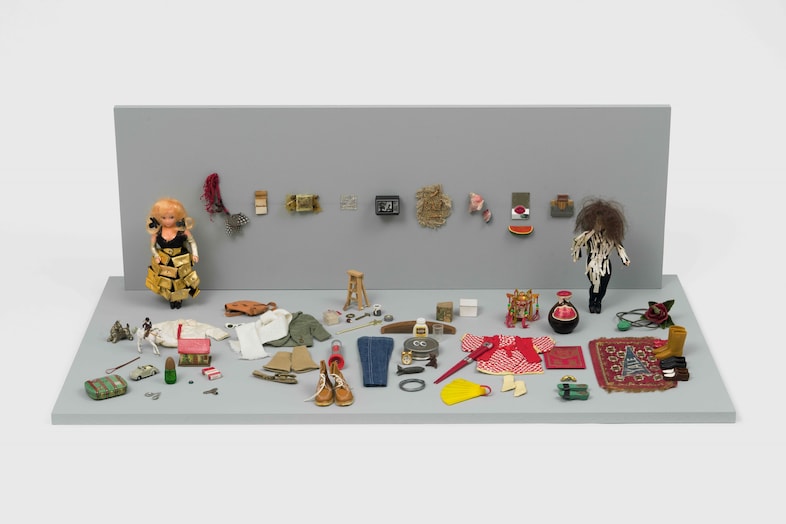
Janet Olivia Henry, Gordon Robichaux and Stars
One of New York’s most esteemed and tenured living artists, Henry is also a recognised educator who has spent a substantial portion of her life working in non-profit and community organisations. Six decades into her career, she brings a tight, 40-year survey of works to Art Basel Paris. These include early works, such as Male Art Dependent (1984), a diorama of the archetypal male gallerist – who collects artists of colour – with all his accoutrements, clothing and possessions, not least a miniature exhibition of works by Black artists. “I made these tiny artworks to represent my friends and peers during that time,” she says, citing David Hammons, Senga Nengudi, Lorraine O’Grady and Howardena Pindell, “to honour them and to also satirise our relationship to exhibition opportunities and the market.”
As early as the 1970s, Henry has been using toys, dolls and miniatures, alongside craft, creative writing and photographic process to make art. As she sees it, her practice is social commentary, attuned to the way objects, materials and textures interact to determine the final object. One such culmination is her new Ritual (Self-Portrait), a life-size soft sculpture. Elsewhere, as part of her Lariat series, photographs, text, vinyl and beading are spliced into assemblage-style hangings. “I use storytelling and play to critique gender, race and class, and to comment on what I observe,” she says. “I look outward and, in turn, look back at myself.”
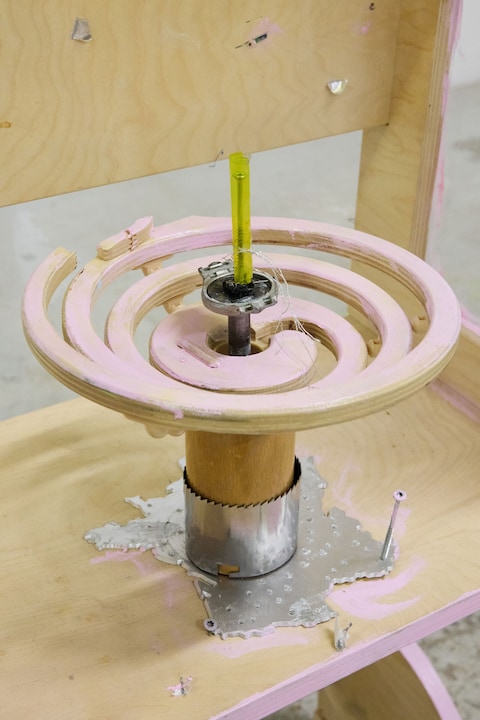
Ethan Assouline at Gauli Zitter
Paris-based artist Ethan Assouline has a rigorously conceptual practice, one that addresses neoliberalism, language and policy through the media of writing, publishing, drawing, sculpture and installation. A master in world-building, he’s drawn to young people because, perhaps unlike otherwise settled elders, they have the potential to imagine alternative ways of being. He always works in a varied manner. At the moment, he tells us, that means drawing, collage and video work that offer “a gay critique of phallic architecture”, and a book charting an exchange of letters with a baby developing its own political theory.
For Art Basel Paris, he is continuing a dialogue set out in his recent solo with Gauli Zitter, Brussels. Entitled dissociation variations, the contained exhibition brings his own clock designs and children’s furniture into a fruitful assembly. “I use these objects to expose obsessions that I have had for a long time: the multiple meanings of the word autonomy, the organisation of time, the representation of violence, decorative absurdity, false ideas of joy and its representations,” he says.
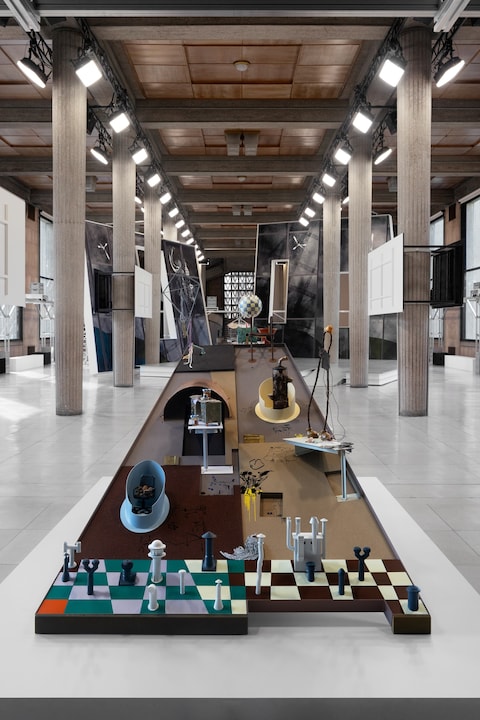
Helen Marten at Palais d’Iéna
Just 22 minutes on foot – or 13 in an Uber – is the Palais d’Iéna, home again to the fair’s Miu Miu-backed public program commission, a multi-media performance piece by Sadie Coles-repped wunderkind, Helen Marten. Entitled 30 Blizzards, the resulting work comprises sculpture, video and choreographed movements concocted with the help of theatre director Fabio Cherstich and a score by musician Beatrice Dillon. Winner of the 2016 Turner Prize, Marten is a true wordsmith – and a published novelist herself (see: The Boiled in Between, 2020). As such, this new commission engages in a language game of sorts.
Cherstich started collaborating with Marten in July, working on the sequencing and dramaturgy. Together, they workshopped their ideas with the objective to let words, bodies and sound coexist without hierarchy. As he describes it, “like parts of one strange organism breathing together”. For him, working with Marten was like stepping into a “moving sculpture”. “Translating her words into a script for performative actions and songs was both a pleasure and a puzzle.”
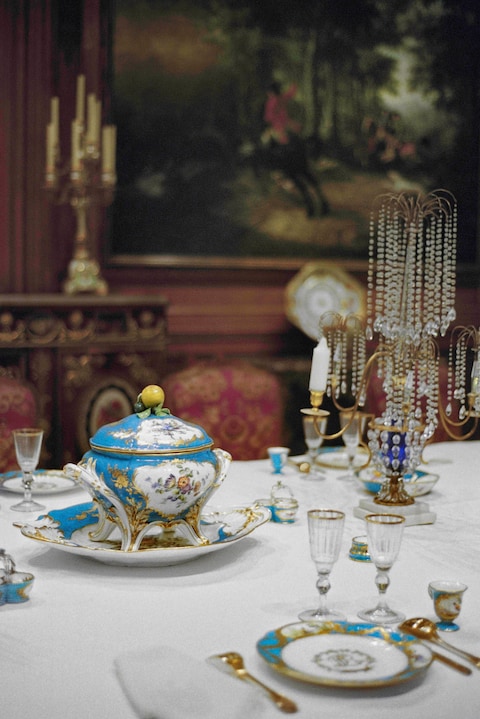
Sophie Kovel at Petrine
Sophie Kovel is a New York-based artist cum micro-historian, or, as she describes herself, “an untrained journalist, a harried symbologist, maybe even a Cassandra.” Delving into signs and displays of wealth, capital and power, she approaches her work like an investigator, placing inordinate amounts of attention on singular projects. Recently, for a show at Diez Gallery, Amsterdam, that meant a curt photographic survey of Jeff Bezos’ hedged estate in Hollywood. On another occasion, she reproduced the wallpaper from the White House’s Diplomatic Reception Room.
For Art Basel Paris, Kovel continues her fascination with the nuance of property, labour and ownership, turning her lens to the imperial collections of an American cereal tycoon, Marjorie Merriweather Post – apparently, once, the richest woman in the world. Her items were later, Kovel reveals, gifted to a national museum. “There is no singular philanthropy,” she says. “I hope, by looking at the collections, symbols and aspirations of one specific philanthropist, to raise a mirror to ethnonationalism, past and present.” It’s perhaps pertinent that Kovel shows this new work, Donations and Estates, at Art Basel Paris, an event whose lifeblood is indeed financial patronage.

Kandis Williams at Heidi
Challenging yet visually rich, Kandis Williams’ work has, for over a decade, questioned the status quo around representation, particularly regarding Black bodies. Using collage, film, performance, sculpture and critical writing, the artist and academic has picked away at nationalist and racist superstructures, bringing hidden mechanics to the fore. She heads up Cassandra Press, a publisher-slash-thinktank creating zines and printed matter, and hosting intensive pedagogical events. (At one point, the latter included actively segregated – by race or socio-economic background – classes, an exemplar of her upfront approach.)
For Art Basel Paris, Williams presents a new body of work departing, specifically, from the history of Black American soldiers in South Korea. Via video footage, archival material and notes, the research, she explains, “investigates how the spectral residues of war shape history, cinema and lived experience.” Of special note is the work, You’re under arrest, sugar (…) (2023), which collages representations of Black femme women in pop culture – Beyonce and Oprah, notably – alongside darker wartime elements in rousing, cross-temporal vignettes. As ever, her method works to deconstruct and thus offer new avenues of resistance.
Art Basel Paris is on show at the Grand Palais from October 24 to 26.
in HTML format, including tags, to make it appealing and easy to read for Japanese-speaking readers aged 20 to 40 interested in fashion. Organize the content with appropriate headings and subheadings (h1, h2, h3, h4, h5, h6), translating all text, including headings, into Japanese. Retain any existing
tags from
From Miu Miu’s Helen Marten commission to the visually rich work of Kandis Williams, here are eight highlights from Art Basel Paris 2025
Hot on the heels of Frieze London comes Art Basel Paris, a highlight in the Swiss franchise’s growing arsenal of global trade fairs. With some 206 galleries in participation this year, the event sees the Grand Palais – a 20th-century glass-roofed landmark off the Champs-Élysées – come alive with patrons, dealers, curators and critics, each attempting to see as many works as possible. Last year, there were around 336 art fairs across the world. Art Basel Paris was and remains one of the most important.
Luckily, Art Basel Paris is smartly laid out, separated into three core sections: Galeries, Emergence and Premise. Respectively, they purvey impressive multi-artist displays, newer artists and tight, curatorially acute presentations. These are joined by innumerable satellite happenings. Conversations, a successful talks series, held in the adjacent Petit Palais, is exemplary. Last year, the billing included fashion designers August Barron (then All-In), K-Hole’s Dena Jago, artists Ana Viktoria Dzinic, Jamian Juliano-Villani, Diego Marcon, Jane Dickson and Futura 2000, plus poet James Massiah and curator Hans Ulrich Obrist. This year, a series dedicated to the 90s – curated by Edward Enninful and featuring Mark Leckey, Yinka Shonibare, Sonia Boyce and Juergen Teller – takes centre stage, alongside a talk with photographer Tyler Mitchell.
All this comes at a particularly fraught period for the art world. In tandem with a volatile economy and geopolitical unrest, the global art market, per Art Basel and UBS, has shown dwindling sales in the past two years. It has, however, displayed some positive signs in the sales of lower price point works, hopefully making way for both rising and overlooked artists.
From young artist Siyi Li, through to mid-career star, Kandis Williams, here are the highlights from Art Basel Paris.

Siyi Li at Cibrián
It’s rare that a Gen-Z artist would pick up traction as fast as China-born Siyi Li. Living and working between Shanghai and Frankfurt, Li studied at the Slade (BA) and Städelschule (Meisterschüler). He approaches his work through a medley of media – painting, drawing, sculpture, film, photography, music – using them to unpack complex, messy emotions and to crystallise ephemeral moments. “I’m obsessed with temporality in my work – whether it’s the idea of longevity or a millisecond of the shutter,” he explains.
In this vein, he is showing a film, New Energy (2025), alongside the study drawings for it. Shot in Shanghai with a cast of artist friends, the work started life as a photo editorial, later morphing into a narrative-led video. Through a series of scenarios, the actors present the exacting resilience – witty in the face of chaos yet totally present – that a city like Shanghai breeds. The immediacy of fashion and the gradual cadence of cinema are, here, combined. “Using the Chinese term for electric vehicles as a metaphor, New Energy is, in a way, an open-ended answer to the role of creativity – whether through fashion, art or any form, it remains crucial to our vitality, especially in urgent [times],” notes Li.

Tanoa Sasraku at Vardaxoglou
Already showing at ICA London for her institutional solo, Sasraku arrives in Paris with a large-scale, sculptural counterpart. At the former, 32 acrylic paperweights containing crude oil are on display – amongst other works – and at the latter, a monolithic, free-standing work called Mascot, fabricated from newspaper, thread, ink and mineral pigments (from Cornwall and Ghana) and wood. Both, explains the Glasgow-based artist, interrogate notions of masculine ambition – to accumulate wealth and power, say – and loss. They also, pertinently, represent elements of her own heritage.
A Goldsmiths and Royal Academy alum, Plymouth-born Sasraku has made her name on salvaged and heavily wrought works. Textiles and patternmaking are an integral part of the practice, informed by her late Ghanaian father Kofi Ansah’s history as a fashion designer. “The work that I am presenting at Art Basel Paris is the climactic expression of this material and formal language,” she says. “In a way, it is a resurrection of and monument to previous works.”

Jala Wahid at Sophie Tappeiner
Arresting, ostensibly toxic and rigorous, Jala Wahid’s work takes root in her study of state violence, empire and colonialism. Based in London, the artist has built a practice spanning film, sculpture, installation and even sound, however, as she puts it, subjects are always tackled through a “material” lens, “looking at the potential and charge of material in carrying and conveying histories.”
For Art Basel Paris, she presents a body of work entitled Stealth Technology, a reference to anti-detection tactics employed by militaries, as well as her parents’ less academic but equally ingenious methods of hiding while fleeing Kurdistan in the mid-80s. In one particular sculpture, Behind the Scenes (2025), the goggles of a military helmet are carved with the words, “date night”, an ode to the fact that even while living in an Iranian refugee camp, her parents found ways to love, despite mortal danger. “I see the sculptures as sites of collision where the visual languages of both are caught on the verge of pulverising one another, moments of violence found in combination with moments more intimate and resilient,” the artist explains.

Janet Olivia Henry, Gordon Robichaux and Stars
One of New York’s most esteemed and tenured living artists, Henry is also a recognised educator who has spent a substantial portion of her life working in non-profit and community organisations. Six decades into her career, she brings a tight, 40-year survey of works to Art Basel Paris. These include early works, such as Male Art Dependent (1984), a diorama of the archetypal male gallerist – who collects artists of colour – with all his accoutrements, clothing and possessions, not least a miniature exhibition of works by Black artists. “I made these tiny artworks to represent my friends and peers during that time,” she says, citing David Hammons, Senga Nengudi, Lorraine O’Grady and Howardena Pindell, “to honour them and to also satirise our relationship to exhibition opportunities and the market.”
As early as the 1970s, Henry has been using toys, dolls and miniatures, alongside craft, creative writing and photographic process to make art. As she sees it, her practice is social commentary, attuned to the way objects, materials and textures interact to determine the final object. One such culmination is her new Ritual (Self-Portrait), a life-size soft sculpture. Elsewhere, as part of her Lariat series, photographs, text, vinyl and beading are spliced into assemblage-style hangings. “I use storytelling and play to critique gender, race and class, and to comment on what I observe,” she says. “I look outward and, in turn, look back at myself.”

Ethan Assouline at Gauli Zitter
Paris-based artist Ethan Assouline has a rigorously conceptual practice, one that addresses neoliberalism, language and policy through the media of writing, publishing, drawing, sculpture and installation. A master in world-building, he’s drawn to young people because, perhaps unlike otherwise settled elders, they have the potential to imagine alternative ways of being. He always works in a varied manner. At the moment, he tells us, that means drawing, collage and video work that offer “a gay critique of phallic architecture”, and a book charting an exchange of letters with a baby developing its own political theory.
For Art Basel Paris, he is continuing a dialogue set out in his recent solo with Gauli Zitter, Brussels. Entitled dissociation variations, the contained exhibition brings his own clock designs and children’s furniture into a fruitful assembly. “I use these objects to expose obsessions that I have had for a long time: the multiple meanings of the word autonomy, the organisation of time, the representation of violence, decorative absurdity, false ideas of joy and its representations,” he says.

Helen Marten at Palais d’Iéna
Just 22 minutes on foot – or 13 in an Uber – is the Palais d’Iéna, home again to the fair’s Miu Miu-backed public program commission, a multi-media performance piece by Sadie Coles-repped wunderkind, Helen Marten. Entitled 30 Blizzards, the resulting work comprises sculpture, video and choreographed movements concocted with the help of theatre director Fabio Cherstich and a score by musician Beatrice Dillon. Winner of the 2016 Turner Prize, Marten is a true wordsmith – and a published novelist herself (see: The Boiled in Between, 2020). As such, this new commission engages in a language game of sorts.
Cherstich started collaborating with Marten in July, working on the sequencing and dramaturgy. Together, they workshopped their ideas with the objective to let words, bodies and sound coexist without hierarchy. As he describes it, “like parts of one strange organism breathing together”. For him, working with Marten was like stepping into a “moving sculpture”. “Translating her words into a script for performative actions and songs was both a pleasure and a puzzle.”

Sophie Kovel at Petrine
Sophie Kovel is a New York-based artist cum micro-historian, or, as she describes herself, “an untrained journalist, a harried symbologist, maybe even a Cassandra.” Delving into signs and displays of wealth, capital and power, she approaches her work like an investigator, placing inordinate amounts of attention on singular projects. Recently, for a show at Diez Gallery, Amsterdam, that meant a curt photographic survey of Jeff Bezos’ hedged estate in Hollywood. On another occasion, she reproduced the wallpaper from the White House’s Diplomatic Reception Room.
For Art Basel Paris, Kovel continues her fascination with the nuance of property, labour and ownership, turning her lens to the imperial collections of an American cereal tycoon, Marjorie Merriweather Post – apparently, once, the richest woman in the world. Her items were later, Kovel reveals, gifted to a national museum. “There is no singular philanthropy,” she says. “I hope, by looking at the collections, symbols and aspirations of one specific philanthropist, to raise a mirror to ethnonationalism, past and present.” It’s perhaps pertinent that Kovel shows this new work, Donations and Estates, at Art Basel Paris, an event whose lifeblood is indeed financial patronage.

Kandis Williams at Heidi
Challenging yet visually rich, Kandis Williams’ work has, for over a decade, questioned the status quo around representation, particularly regarding Black bodies. Using collage, film, performance, sculpture and critical writing, the artist and academic has picked away at nationalist and racist superstructures, bringing hidden mechanics to the fore. She heads up Cassandra Press, a publisher-slash-thinktank creating zines and printed matter, and hosting intensive pedagogical events. (At one point, the latter included actively segregated – by race or socio-economic background – classes, an exemplar of her upfront approach.)
For Art Basel Paris, Williams presents a new body of work departing, specifically, from the history of Black American soldiers in South Korea. Via video footage, archival material and notes, the research, she explains, “investigates how the spectral residues of war shape history, cinema and lived experience.” Of special note is the work, You’re under arrest, sugar (…) (2023), which collages representations of Black femme women in pop culture – Beyonce and Oprah, notably – alongside darker wartime elements in rousing, cross-temporal vignettes. As ever, her method works to deconstruct and thus offer new avenues of resistance.
Art Basel Paris is on show at the Grand Palais from October 24 to 26.
and integrate them seamlessly into the new content without adding new tags. Ensure the new content is fashion-related, written entirely in Japanese, and approximately 1500 words. Conclude with a “結論” section and a well-formatted “よくある質問” section. Avoid including an introduction or a note explaining the process.
